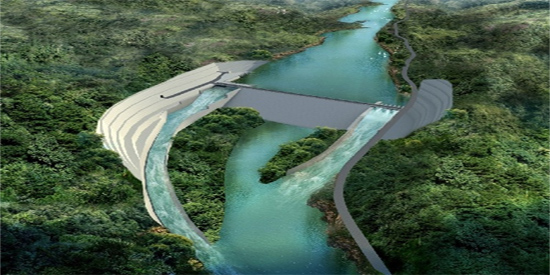
NARAN: Though Kaghan is famed for its picturesque landscape, frothing streams and rivers and hospitable people, the Suki Kinari Hydropower Project – set to produce 870 Megawatts (MW) of clean and environment-friendly electricity – is going to give it another identity.
A part of China, Pakistan Economic Corridor (CPEC), this is the largest project of its kind not just in Kaghan but in the entire KP, with the exception of Tarbela. A run-of-the-river project at 166-kilometre-long Kunhar, which originates at the Lulusar Lake nearly 48 kilometres upstream from Naran Valley, runs through the valley and ends up in the Jhelum River.
Mr Li Yuanling, a counselor at the Chinese Embassy, told Pakistan Today that Suki Kinari is a key CPEC initiative.
Lauding the services of media to highlight the CPEC, Mr Li said that Pakistan, China friendship would get further cemented through its effective implementation, ushering the welfare and wellbeing of the people of the entire region. He said the Chinese staff in Pakistan would do their best in welfare activities in across Pakistan to contribute to Belt and Road Initiative.
Being developed on a Build-Operate-Transfer (BOT) model, the project’s total cost is US$1.9 billion and it is. Hence, it would not be a burden on the KP government as the company, CGGC, would operate it for 30 years and then transfer it to the KP government.
Though Pakistan had identified hydropower generation strength of River Kunhar in the mid-50s, the study was commenced in 1960 but this potential could never be harnessed until CGGC took it up in 2016.
Run-of-the-river projects envisage are designed to draw water from the river, take it to the turbines in a powerhouse located downstream through tunnel and after producing energy, divert it back to the river – with water remaining available to produce energy through yet another similar set up downstream. This process is called cascading.
In addition to Suki Kinari project, two more projects have been announced by KP government at Batakundi (96 MW) and Naran (188MW) – both upstream of the Suki Kinari project.
Another project Patrind (147 MW) is already underway downstream. So in all there would be four hydropower projects on Kunhar River with a total capacity of 1300 MWs.
A site visit by Pakistan Today revealed that China Gezhouba Group Corporation (CGGC), the main contractor, has undertaken the project with vigour and speed.
Unlike others, Suki Kinari is the largest private sector Hydropower Project in Pakistan. The diversion and intake structure (dam site) is located near the village of Andera Bela, upstream of Kaghan town.
The underground powerhouse is located near the town of Paras. Unlike other rivers, Kunhar originates and terminates within Pakistan, thus no international interference or complexity is involved with the project. This is the only hydropower project in Khyber Pakhtunkhwa on the CPEC list.
Listed as the high priority within the CPEC, it’s being closely monitored by the governments of Pakistan and China.
The dam body is 54.5 metres high from the river bed level, with and its length 228 metres at the crest level. The reservoir length is 3.1 km and width 300 metres. Headrace tunnel is 22.58 km long while its diameter is six meters. The twin tunnel tailrace is 806 metres long and its diameter is six metres. The UG powerhouse is 400 meters in depth below ground level.
Four Pelton turbines have been installed to develop 221 MWs. The water head is 922 meters, 845 meters per minute. The annual power generation is estimated at 3.212 billion kWhs.
The construction period is six years. Since the project was commenced on December 31, 2016, it would be completed by 31 December 2022.
Mr Zhang Zhiping, Director Administration of Suki Kinari project, told Pakistan Today that the CGGC had undertaken various welfare projects under its corporate social responsibility initiative to benefit the inhabitants of the area.
He said 3.081 billion MWs of mean annual power will be generated during the formal operation of SKHPP and it would help alleviate Pakistan’s chronic energy shortages, optimize power consumption structure and promote economic development.
He said around 1,600 Pakistani people work in SKHPP including over 900 skilled and over 700 labourers.
About the company’s recruitment plan for the years 2019 and 2020, the company would provide another 3,000 jobs for the locals.
“The majority of locals have no experience of working in a hydropower or other engineering projects, and need to be trained by Chinese foreman and skilled workers such as surveyors, operators of heavy equipment, carpenters, electricians, welders, plumbers etc.,” he said.
Pakistani officials predict that CPEC will result in the creation of upwards of 2.3 million jobs from 2015 to 2030 – adding 2 to 2.5 percentage points to the country’s annual economic growth, he added.
Other than direct job creation, Mr Zhiping said the project had boosted local businesses as cement, reinforcement, aggregate, diesel, explosive etc. have strongly been used by the construction of SKHPP.
“The demand of cement alone is 383,000 tons, priced at Rs4.6 billion while so far 22,000 tons has been procured with an outlay with the amount of Rs 264 million. The demand of reinforcement is 41,280 tons at another Rs 4.3 billion. The purchased quantity of reinforcement is 2,900 tons with at Rs302 million”.
He said the demand for diesel is 29.8 billion liters with the amount of Rs 3.4 billion while purchased quantities of diesel is Rs 385 million.
“The demand of explosives is 3723 tons with the amount of Rs 1.5 billion. The cost of the purchased quantity of explosives is Rs90 million,” he added.
To elaborate further, Ms Guan, an administrative assistant, said that in 2017, the Balakot Bridge was damaged by flash floods for a long term and was not allowed to pass through. It was not only a big challenge for SKHPP but also influenced local traffic. However, he said, the CGGC received the request letter from NHA to help repair the damaged part of this bridge.
“The CGGC and NHA reached an agreement immediately that CGGC assisted to build the Bailey bridge above the damaged part without any cost. It took ten days to complete the construction of Bailey Bridge – receiving high appreciation from NHA, local government and local people,” she added.
Mr Zhiping added that the company also constructed seven bridges on Kunhar River from Naran to Paras, handing them over to the community once the construction work ends.
He said, the Chinese staff also observed “Learn from Lei Feng Day” and on March 5, the Chinese staff visits the various community and school events where they clean up parks, schools, and other community locations or offer help to others.
“The China Gezhouba Group Corporation takes this opportunity to carry forward traditional cultures through denoting school supplies and teaching the Chinese language to local students, to be followed up further,” said he.






















